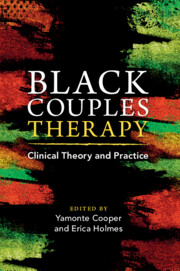Book contents
- Black Couples Therapy
- Black Couples Therapy
- Copyright page
- Contents
- Figures
- Tables
- Contributors
- Foreword
- Acknowledgments
- Introduction
- Part I Race, Racism, and Identity
- Part II Foundations for Healthy Coupling
- Part III Adapting Major Therapeutic Approaches for Work with African American Couples
- Chapter 6 Emotionally Focused Therapy with Black Couples
- Chapter 7 Use of the Gottman Method with African American Couples Impacted by Post-Traumatic Slave Syndrome
- Chapter 8 Transcending the Binary: A Narrative Therapy Approach to Work with Black Trans Men Navigating Gender Transition with Romantic Partners
- Chapter 9 Imago Therapy and the African American Couple
- Chapter 10 African American Narratives of Trauma: An EMDR Approach to Tapping into the Strengths of Black Love
- Part IV Sex and Intimacy
- Part V Special Topics
- Index
- References
Chapter 10 - African American Narratives of Trauma: An EMDR Approach to Tapping into the Strengths of Black Love
from Part III - Adapting Major Therapeutic Approaches for Work with African American Couples
Published online by Cambridge University Press: 27 July 2023
- Black Couples Therapy
- Black Couples Therapy
- Copyright page
- Contents
- Figures
- Tables
- Contributors
- Foreword
- Acknowledgments
- Introduction
- Part I Race, Racism, and Identity
- Part II Foundations for Healthy Coupling
- Part III Adapting Major Therapeutic Approaches for Work with African American Couples
- Chapter 6 Emotionally Focused Therapy with Black Couples
- Chapter 7 Use of the Gottman Method with African American Couples Impacted by Post-Traumatic Slave Syndrome
- Chapter 8 Transcending the Binary: A Narrative Therapy Approach to Work with Black Trans Men Navigating Gender Transition with Romantic Partners
- Chapter 9 Imago Therapy and the African American Couple
- Chapter 10 African American Narratives of Trauma: An EMDR Approach to Tapping into the Strengths of Black Love
- Part IV Sex and Intimacy
- Part V Special Topics
- Index
- References
Summary
The intergenerational history of racial oppression and injustice for Black Americans is cumulative and traumatic. High rates of trauma combined with a disparity in mental health care can leave many Blacks without adequate resources to cope with the magnitude of the distress they experience. As a result, when those with traumatic pasts enter relationships, they are often underprepared for the demands of maintaining emotional connection and the synergistic effect of their pain. This chapter explores Eye Movement Desensitization Reprocessing Therapy (EMDR) as a critical approach needed to address trauma’s neurological, emotional, and relational impact. It provides a culturally relevant model of applying EMDR to create a healing space for building self-efficacy, worth, trust, and intimacy within Black romantic partnerships.
- Type
- Chapter
- Information
- Black Couples TherapyClinical Theory and Practice, pp. 235 - 252Publisher: Cambridge University PressPrint publication year: 2023



